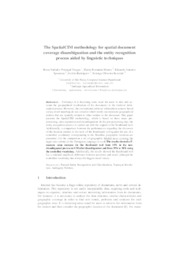The SpatialCIM methodology for spatial document coverage disambiguation and the entity recognition process aided by linguistic techniques.
The SpatialCIM methodology for spatial document coverage disambiguation and the entity recognition process aided by linguistic techniques.
Author(s): VARGAS, R. N. P.; MOURA, M. F.; SPERANZA, E. A.; RODRIGUEZ, E.; REZENDE, S. O.
Summary: Abstract. Nowadays it is becoming more usual for users to take into account the geographical localization of the documents in the retrieval information process. However, the conventional retrieval information systems based on key-word matching do not consider which words can represent geographical entities that are spatially related to other entities in the document. This paper presents the SpatialCIM methodology, which is based on three steps: pre-processing, data expansion and disambiguation. In the pre-processing step, the entity recognition process is carried out with the support of the Rembrandt tool. Additionally, a comparison between the performances regarding the discovery of the location entities in the texts of the Rembrandt tool against the use of a controlled vocabulary corresponding to the Brazilian geographic locations are presented. For the comparison a set of geographic labeled news covering the sugar cane culture in the Portuguese language is used. The results showed a F-measure value increase for the Rembrandt tool from 45% in the non-disambiguated process to 0.50 after disambiguation and from 35% to 38% using the controlled vocabulary. Additionally, the results showed the Rembrandt tool has a minimal amplitude difference between precision and recall, although the controlled vocabulary has always the biggest recall values.
Publication year: 2012
Types of publication: Paper in annals and proceedings
Observation
Some of Embrapa's publications are published as ePub files. To read them, use or download one of the following free software options to your computer or mobile device. Android: Google Play Books; IOS: iBooks; Windows and Linux: Calibre.
Access other publications
Access the Agricultural Research Database (BDPA) to consult Embrapa's full library collection and records.
Visit Embrapa Bookstore to purchase books and other publications sold by Embrapa.

